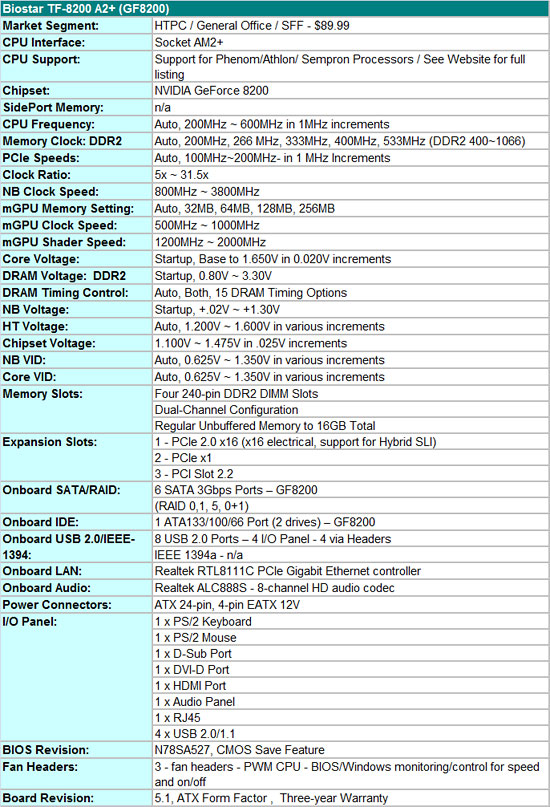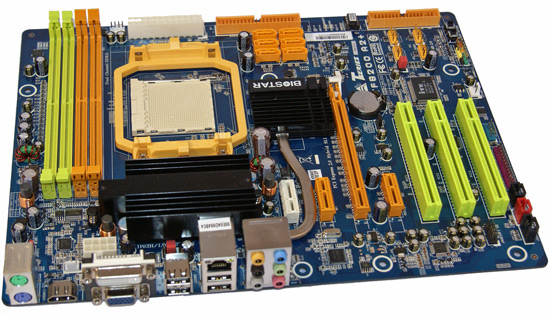The IGP Chronicles Part 2: AMD 780G vs. Intel G45 vs. NVIDIA GeForce 8200
by Gary Key on October 14, 2008 12:40 PM EST- Posted in
- Motherboards
The Motherboards
We've got a quick spotlight here on the boards we used to represent the AMD and NVIDIA chipsets included in this article.
NVIDIA GeForce 8200 from Biostar
Representing the GF8200 product family today is the Biostar TF-8200 A2+, which is part of Biostar’s T-Series family that offers a blend of performance features at a near value price point. This board features an ATX layout, support for NVIDIA Hybrid SLI, a feature rich BIOS, and a price of $89.99. Major competitors in the GF8200 arena include the ASUS M3N78-VM HDMI, MSI K9N2GM-FD, ECS GF8200A, and Zotac GF8200.

The TF-8200 A2+ is a feature rich GF8200 board with an OC friendly BIOS, Gigabit LAN via the almost universal Realtek RTL8111C, full RAID support along with six SATA ports via the GF8200, PATA support from the GF8200, and HD audio via the Realtek ALC888S. One interesting fact about SATA support from the GF8200/8300 series is that ports five and six only support AHCI or RAID mode; otherwise you are limited to four SATA ports.

In our opinion, Biostar provided an excellent layout with an old school AMD memory slot configuration. When utilizing a dual slot video card, the user is still left with with two free PCIe x1 and three PCI slots. The chipset heatsink designs did not interfere with a variety of peripherals that we installed including several popular heatsinks and video cards. Our only complaint would be the GF8200 runs slightly hot under load so we recommend active cooling (case fan or radial CPU fan design) in order to keep the chipset and PWM components cool.
Biostar utilizes an excellent 4-phase power delivery system along with quality capacitors throughout the board that resulted in very stable operation with everything from a 9950BE down to a BE-2400. The inclusion of PS/2 ports for a keyboard or mouse is a nice touch as is output support for VGA, HDMI, or DVI-D along with power and restart buttons. DVI-D support is limited to single link, so 1920x1200 is going to be the maximum desktop resolution. This is a limitation of the NVIDIA GF8200 chipset.
Pros/Cons
We had an interesting time with this board. Up until the latest NVIDIA platform and driver set, our interest in the GF8200 has never been that great. Besides the exclusion of a 5.1 channel HDMI audio setting, things are finally looking up for this chipset. As such, our opinion of the board changed slightly.
All of our AMD based boards today were limited in overclocking to around 250HTT with integrated graphics enabled. We were able to run the GPU shader clock to 1650MHz and the mGPU core clock to 630MHz. Increasing the core clock provided very little benefit, and increasing the shader clocks raised performance anywhere from 2% to 4% on average.
The Biostar board was extremely stable when clocking our 9950BE up to 234HTT, 8750 at 240HTT, and the 4850e at 245HTT with base memory clock set to DDR2-800 with 5-4-4-15 settings. We will delve into additional overclocking with our discrete GPUs shortly, but for those needing a IGP solution with overclocking, this board is recommended.
We had a couple of minor problems that a BIOS update should cure. The keyboard is not available after drive recognition until the Windows startup routine and HTT clocking with the 9350e was difficult. In addition, HDMI video out no longer works with the latest PowerDVD 8 Ultra update 2021a and the 178.13 driver set on this board. Either the EDID information or AACS key update is creating a conflict with the current BIOS. We rolled back to an earlier version and all was fine again for BD playback. Overall, this board did not inspire us but neither did it create any negative feelings during use. Biostar has provided a solid board with a very good feature set that we find hard to fault.














41 Comments
View All Comments
tonyintoronto - Wednesday, October 15, 2008 - link
The issue is the 780G just doesn't work well enough to be used in htpc.. tons of issues with hdcp and different monitors/tv's, still can't decode mpeg2 stream without crashing the display driver, issues with open GL, was a great idea but bad drivers/hardware have done it for me.. now, the 9300 and 9400 looking nice :)Mathos - Tuesday, October 14, 2008 - link
Hmmmmm Actually the power numbers aren't too bad when you take it into context. Q9300 is a 45nm chip, and 9950 is 65nm. Q9300 is 95w TDP rated, but runs much lower actual TDP. While the 9950 is rated 125w TDP. I'd be interested in seeing this test redone once Deneb variants come out. Considering the lesser performance of the Phenom compared to the Penryn, it actually speaks well of both the AMD based chipsets, and shows that the 790GX does a lot to make up for the processor.I'd say AMD/ATI are doing a good job on the Chipset front now.
Calin - Tuesday, October 14, 2008 - link
Also, considering we're talking about a $174 versus a $260 processor. I wonder what the results were if the comparation would have been against the quad core Q6600 (at a somewhat similar price of $189).3DoubleD - Tuesday, October 14, 2008 - link
"However, they are offering 8-channel LPCM support on the HD 4xxx series of video cards. Of course that option comes with an additional cost and potential problems such as incompatibility with AVR receivers such as those from Yamaha"Can you elaborate on these problems? I was planning on building an HTPC system and was considering this exact combination. Are these temporary (driver update solvable) problems?
This second question is only distantly related to this article. When using the HDMI with LPCM audio, will sound from sources other than Blu-ray discs (such as games or movies with DD5.1 or DTS) be playable on your stereo? Part of me wants to say yes it will for DTS and DD5.1, but I'm skeptical about video games for some reason. I guess I don't fully understand the extent of the sound card capabilities on these IGP/discrete graphics solutions.
Great article, I'm looking forward to your HTPC graphics card review.
AmdInside - Tuesday, October 14, 2008 - link
I own the Asus M3N-H/HDMI (Geforce 8300) and except for the fact that it doesn't have an eSATA port, I have no complaints (well, maybe the placement of the 24-pin power connector).http://www.asus.com/products.aspx?modelmenu=1&...">http://www.asus.com/products.aspx?model...mp;l1=3&...
I recently purchased the Intel G45 Mini-ITX motherboard to build a second HTPC and although it has worked ok for the most part, BD and HD-DVD playback just doesn't seem as smooth as the Geforce 8300. It is not choppy. It just feels like the framerate is lower. I can't explain why. The same HDTV was used with both systems and they were both set to 1080p/60. Both systems are running Windows Vista. If you are building a new HTPC, I would not recommend Windows XP btw with these platforms. Anyways, I appreciated the article. For me, I was trying to build a somewhat portable HTPC with the Intel mini-ITX motherboard but given the problems I am having with BD and HD-DVD playback, I think I am going to leave it as a Windows Media Center DVR box and use the Geforce 8300 as my main HTPC. For what it's worth, I tested with both WinDVD and Arcsoft TMT.
gipper - Tuesday, October 14, 2008 - link
It sounds to me like you're really recommending that at this time the way to go is to get a cheap Intel chipset motherboard with the cheapest, lowest power 45nm Core2 Duo, and an ATI 4550.But what Intel chipset would give that rock solid platform at the lowest price?
tayhimself - Tuesday, October 14, 2008 - link
Neither AMD nor Nvidia can make a decent chipset. Intel seems to have as many misses as they have hits so they're usually a good bet. Boo hiss to poor QC!Nil Einne - Friday, January 30, 2009 - link
As with others, I have to say this is a piss poor review. I looked at the Part 1 and came across a resonably decent review. Was expecting the same thing here. But what do I come across? You onmly test two quad cores. What idiot buys a quad core for their HTPC? Unless you're transcoding there's absolutely no reason and given the price of HDs nowadays and the fact that some broadcasters are using AVC for their HD content anyway there's only a few people who are going to bother. Even if you are occasionally transcoding, it's questionable of you really need a quad core or it might be better to just stick with a dual. At the very lest you could have tested quad cores and dual cores like you did with the previous review. But you didn't and so have a fairly useless review for 99% of the population. Why did you even bother with gaming anyway? Seriously, how many people game with quad core IGP systems particularly the kind of games you were testing. And how many of those check out Anandtech reviews? Maybe 5 people in the whole world... You may use a quad core IGP for a high load server or a non-3D workstation but not gaming.As it stands, based on your previous review (part 1, i.e. the one with the G35) and your comparison between the G35 and G45 I'm guessing that the 8200 is probably still better when paired with a decent CPU for most HTPC purposes but only barely. Sadly it's just a guess for the reasons I outlined above
Nil Einne - Friday, January 30, 2009 - link
When I said part 1 I meant the "IGP Power Consumption - 780G, GF8200, and G35", got slightly confused. One of the strangest things about this review of course is the 8200 performed so poorly whereas in that review, it was better then the 780G. Has the 780G improved a lot? Is it just the Gigabute 780G was a POS? Who knows, one would have thought the reviewer would have at least co=mmented on if not investigated this but apparently notlisajack - Saturday, January 18, 2020 - link
Although, with MMA corner standards, I wouldn’t be surprised if somebody told her to go out there and do her best despite being completely out(weight)classed by the scale.<a href="https://www.nogibjjgear.com/collections/rash-guard... guards</a>